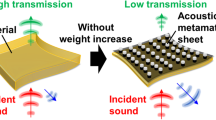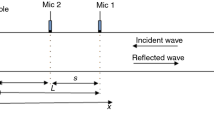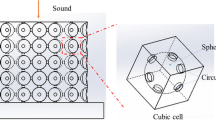Abstract
The acoustic properties of three kinds of polymeric micro-particle materials have been investigated. Based on it, a novel sound absorption material with multi-layered structure has been fabricated by using polymeric micro-particles with low reflection as matching layer and high sound absorption one as sound energy attenuation layer. To optimize the absorption characters in demanded frequency regions, a double impedance matching layers have been created. The experimental results show that the particle materials fabricated by the principle of impedance matching processes excellent sound absorption character in wide frequency regions.
Similar content being viewed by others
Explore related subjects
Discover the latest articles, news and stories from top researchers in related subjects.Avoid common mistakes on your manuscript.
Introduction
In these years, due to heavy increase of sound generation source, such as population concentration in the cities and high-speed, high-output implementation of machines, the noise problem are becoming serious. An increasing demand regarding the human environment and diversification of life styles makes the solution of this problem pressing, and therefore noise control materials, such as polyurethane foam sheets and glass walls, are widely used. However the sound absorptions of those materials are strong in high-frequency regions, while relatively weak in low-frequency regions because of the low capacity of sound energy attenuation.
So many studies turn to the material with high sound attenuation capacity, including powder and granular materials that have excellent sound absorption characters, especially in low frequency region. Allard et al. [1] predicted the surface impedance of a layer of glass beads using the macroscopic parameters such as tortuosity, characteristic dimensions, et al, which are not easy to be obtained. Okudaria et al. [2] and his group investigated the relations of the absorption characters of six powder beds and their physical properties, and found powder materials have characteristic absorption peak, but the peaks are narrow. Recently, polymeric particles are extensively applied for absorption of sound and reduction of noise. Its attractive properties include its excellent viscoelasticity, relatively simple processing characteristics, and the fact it is commercially available. Voronina and Horoshenkov [3] and Swift et al. [4] studied the absorption characters of recycled rubber granulates, by using flow resistivity and physic no-acoustic parameters to prediction the absorption coefficients of the granulate materials. Ootsuta and Shuichi [5] developed an acoustic panel using sound-absorbent plastic acoustic-insulation material formed by subjecting thermoplastic resin beads to heat pressure. Unfortunately for the distinctly impedance mismatching between absorber and air, the absorption characters are not so good in wide frequency region. To reduce the mismatching extent between the particles with high sound attenuation capacity and the air, Forest et al. [6] employed a matching layer to overcome this problem. Zhou et al. [7] using polyurethane foam as matching material, created a novel sound absorption materials of polymeric particles so as to the sound wave can easily go into the sound absorption material and be attenuated by the polymeric particle.
Aim to above gaps, in this paper; a two-thickness method has been used to calculate the characteristic impedance of model materials of polymer particles: WR (wasted rubber granulate) particles, PP (polypropylene) particles and PS (polystyrene) particles. And then, the acoustic properties of single matching layer material with an impedance matching layer and a sound absorption one have been fabricated. To improve the characteristic impedance matching between particle material and air, a double matching layer become a applicable approach, where PS particles was selected as the first matching layer with low characteristic impedance, and PP particles layer with higher characteristic impedance as the second matching layer, WR particles as the sound attenuation layer. Thus, the characteristic impedance of the matching layers can be remarkable modified through changing the thickness of the two matching layers.
Theory background
The two-thickness method was developed first by Smith and Parrott [8] to measure the characteristic impedance Z c and propagation constant γ of bulk materials. This method exploits changes of the surface impedance Z1 and Z2 of test samples with thickness L and 2L (and the surface impedance) which can be obtained by measuring respectively to the thickness L and 2L, can be related to Z c and γ by formula (1) and (2)
Then, it can be deduced that
The value of the absorption coefficient (α n ) is calculated from the following express
where r is the real part of surface impedance, x is the image part of surface impedance.
Experimental
Measurement of acoustic properties
The acoustic properties have been measured using a two-microphone impedance tube B&K4206 made by Bruel & Kjaer (B&K) Co, Swiss, in the frequency range of 100–6,500 Hz. With this set-up the impedance of each sample has been measured without an air gap. The experiment setups were described in Fig. 1.
Samples used in the experiment
Three kinds of polymeric micro-particles with different structures, size and size distributions were used, and the non-acoustic parameters for those materials are shown in Table 1.
Result and discussion
Acoustic properties of particle layers
The absorption curves of the three materials of WR, PP and PS particles are shown in Fig. 2, from which it can be found that the absorption character of WR particles is excellent at frequencies below 1,000 Hz while that of PS particles material and PP particles material are outstanding at frequencies beyond 1,000 Hz. The phenomenon can be attributed to the fact that the high sound reflection on the surface of the WR particles material weakens its absorption character in high frequency region. At the same time, the low sound attenuation capability results in lower sound absorption for PS particles and PP particles.
The characteristic impedances ratio (Z c), the inherent property of the materials were calculated according to the two-thickness method and shown in Fig. 3. The real and imaginary parts of Z c, which represent the resistance and reactance feature of materials [9], indicate the sound attenuation and reflection capacity of the materials respectively. As shown in Fig. 3, the sound attenuation and reflection capacity of WR particle are both more remarkable than those of the other two, which result in the absorption characters of WR particle, comparing to PP particle and PS particle. Consequently, it is clear that the sound absorption characters of the materials are cooperative actions of its resistance and reactance properties.
As shown in Fig. 4a, the experimental data of surface impedance indicated that the attenuation capacity of the WR particle is strongest among these three materials as mentioned above. However, the absorption coefficient of WR micro-particle is not so good between 1,000 and 5,500 Hz. It is found that the strongly sound energy reflection result from the distinctly impedance mismatching between the WR particle and air. The imaginary part of the surface impedance ratios of WR particle, in Fig. 4b, is obviously deviated from the value of zero, which exhibits the strong reflection effect.
Therefore, in order to minish the difference of the normalized characteristic impedance ratios between WR particles layer and air, it is suggested to employ a matching layer of low characteristic impedance particles.
Multi-layers absorber
Single matching layered absorber
From reasons mentioned above, single matching layer absorbers have been fabricated by using PS particles and PP particles respectively as impedance matching layers and WR particles as energy dissipation layer. Here the samples with the thickness of 30 mm are employed in investigation, since they allow good comparison to be made and considered technologically possibility to manufacture. Consequently, the assembly for the absorber of WR particles with 10 mm thickness, PS particles with 20 mm thickness and WR particles with 10 mm, PP particles with 20 mm respectively has been discussed here. The absorption curves of those samples S-1 and S-2 are placed in Fig. 5a and b.
Obviously, the sound absorptions of the samples S-1 and S-2 are generally better than that of the single particle layer material with same thickness, especially in some frequency region.
Figure 6 shows the variation of the real part and imaginary part of the surface impedance, Z s, of sample S-1. It can be seen that, in broad frequency range, from 600 to 4,200 Hz, the imaginary part of the composite material is so close to the value of zero, which represented that the reflection of the sound energy is extremely weaken by using matching layer, comparing to pure WR particle. On the other hand, as shown in Fig. 5, the absorption coefficient spectrum of the composite material exhibited a wide absorption band, which demonstrates that the using of impedance matching is benefit to improve the sound absorption.
Comparing Fig. 5a and b, it is found that the absorption band of single matching material shifted towards the low frequencies as the energy attenuation capacity of matching layer rises, which is because of the increased attenuation coefficient of the composite material. And it should be noted that the absorption band frequency of the composite material is just between the matching material and the sound attenuation material. It is revealed that the absorption properties of single matching material will be under control by using different particle materials.
But in high frequency region, the absorption capacity of the single matching sample S-1 is still unsatisfactory, as shown in Fig. 5a, and so is that of sample S-2 in middle frequency region, as shown in Fig. 5b.
The calculated characteristic impedance ratios of WR to PS and PP particle layer were shown in Fig. 7. It is clear that the reflection at the surface between PP and WR particle layer is smaller than that between PS and WR particle layer in whole tested frequency region, while the reflection at the surface between PP and air is extremely stronger than PS and air in middle frequency region. This discrepancy leads to the shortages of both two samples with single matching layer. It is suggested that single matching cannot deal with the problem of impedance mismatching well. Furthermore, for single matching material, if it was going to show greatest absorption properties in a given frequency region, a particle layer with particular impedance is necessary, which is hardly realized.
Thus, a thinkable way, double matching layer, was chosen, in which the characteristic impedance was increased stepwise, using low characteristic impedance material as first matching layer, a higher one as the second and the highest one as the third, sound attenuation layer. At the same time, for the characteristic impedance of the matching layers can be remarkable modified by changing the thickness of the two matching layers, double matching material is expected show greatest sound absorption in given frequency region.
Double matching layered absorber
Based on the two-thickness mode, the characteristic impedance ratio of WR to PS particle layer, WR to PP particle layer and PP to PS particle layer were calculated, as shown in Fig. 8.
Then a double matching layer sample, D-3, was fabricated, in which PS particle was selected as the first matching layer with thickness 10 mm, PP particles as the second matching layer 10 mm, WR particles as the sound attenuation layer with thickness 10 mm. The absorption spectrums of this double matching sample, D-3, and that of single matching samples, S-1 and S-2, were displayed in Fig. 9.
The absorption band frequency of the double matching sample is just between the two single matching layer samples. The double matching samples exhibit good sound absorption in wide frequency region instead of distinct absorption band. Figure 10 shows the spectrum of surface impedance of the double matching sample and the two single matching layer samples.
It is clear that the real and imaginary parts of surface impedance ratio of the double matching sample, exhibiting smoothed curves, are just between the two single matching samples. Thus the sound reflection on the surface of double matching samples is not strong, at the same times, the sound attenuation capacities of the composite materials have not been markedly shorten, which result in the good absorption in wide frequency region. Obviously the particular impedance contributes to the wide absorption frequency region of the double matching sample.
Absorber of double matching layers with tailored thickness
Through change the thickness of the two matching layers, the absorption band of the double matching materials can be shifted. For fixed sample thickness (30 mm) and fixed thickness of attenuation layer (10 mm), the thickness of PP particle layer varied from 5 mm to 15 mm with the step of 5, as well as the thickness of PS particle varied from 15 mm to 5 mm. The absorption spectrums of these three double matching samples D-3–D-5 were displayed in Fig. 11.
As the thickness of the first impedance matching layer increase, the absorption peak frequencies of the double matching layer shifts towards high frequency, and their maximums value are heightened, which is the result of the reducing impedance. When the impedance is reduced, the attenuation capacity of the composite material will be decreased, and the reflection of the composite material will go down greatly.
It is validated that as modifying the thickness of the impedance matching layer, the double matching material will show greatest absorption capacity in demanded frequency range.
Conclusion
By employing two-thickness model, the characteristic impedance of the model materials of polymer micro-particle is calculated. The absorption property of WR micro-particle is not so good in high frequency region due to mismatching of the characteristic impedance between the WR particle and air.
Using low characteristic impedance material, such as PS particle and PP particle, as matching layer and high sound attenuation one, WR micro-particle, as sound attenuation layer, a novel multi-layered material was fabricated. The matching layer obviously diminishes the reflection of attenuation layer. Experimental results of the absorption properties also indicate that the multi-layered material with single impedance matching layer shows good absorption property in wide frequency region.
The double matching layer materials show wide absorption frequency region. And it is possible to obtain a material with greatest absorption properties in the arranged frequency region, through changing the thickness of the two-impedance matching layer.
References
Allard JF, Henry M, Tizianel J (1998) J Acoustic Soc Am 104(4):2004
Okudaira Y, Kurihara Y, Ando H et al (1993) Powder Technol 77:39
Voronina NN, Horoshenkov KV (2003) Appl Acoust 64:415
Swift MJ, Bris P, Horoshenkov KV (1995) Appl Acoust 7:203
Ootsuta K, Shuichi T (1996) Mitsubishi Electric Advance 174(3):18
Forest L, Gibiat V, Hooley A (2001) J Non-Crystalline Solids 285:230
Zhou H, Li B, Huang G (2004) Polym Mater Sci Eng 20(3):191
Smith CD, Parrott TL (1983) J Acoustic Soc Am 74(5):1577
Zwikker C, Kosten CW (1940) Sound Absorption Materials, Elsevier
Acknowledgements
The authors are grateful to the center of testing research of China for their help of the experiment test. This work has made possible with the financial support of a grant from the National Natural Science Foundation of China (project 50273022)
Author information
Authors and Affiliations
Corresponding author
Rights and permissions
About this article
Cite this article
Li, B., Zhou, H. & Huang, G. A novel impedance matching material derived from polymer micro-particles. J Mater Sci 42, 199–206 (2007). https://doi.org/10.1007/s10853-006-1052-1
Received:
Accepted:
Published:
Issue Date:
DOI: https://doi.org/10.1007/s10853-006-1052-1















